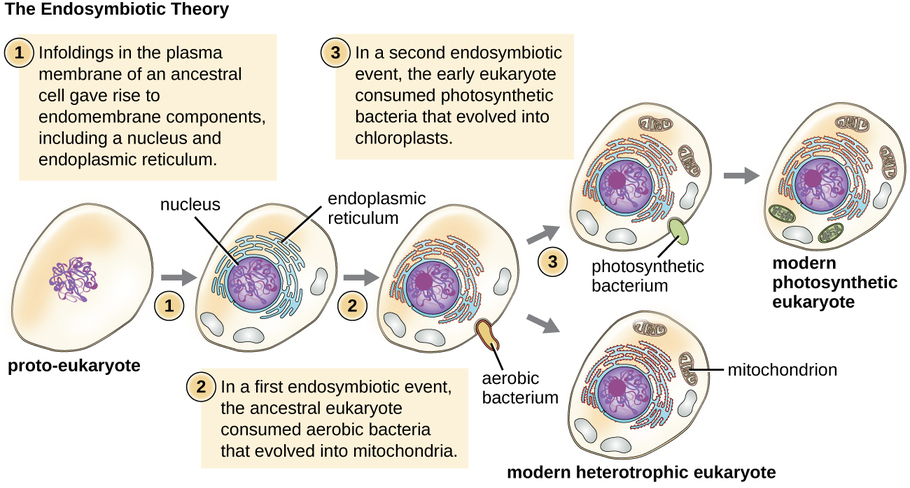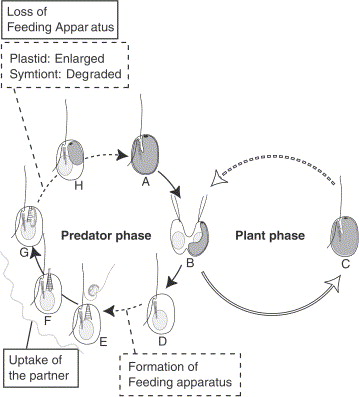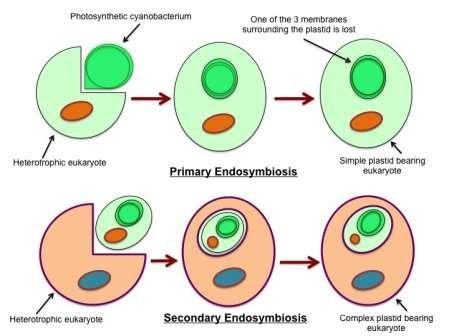Protists – Evolution and Characteristics Study Guide
Introduction
According to the endosymbiotic theory and it’s evidence, scientists propose that the earliest protists evolved from prokaryotes (single-celled organisms) based on available evidence. And that eukaryotic organelles like mitochondria and chloroplasts evolved from prokaryotes that lived within larger prokaryotic cells. This is known as the endosymbiosis theory.
The similarity between the DNA of algae and cyanobacteria, which indicates that cyanobacteria are the evolutionary ancestors of green and red algae, highlights the evolutionary significance of protists.
What is Protist Evolution?
Some important characteristics arose in protists during their evolution as explained by the endosymbiotic theory and it’s evidence.
- There was a nucleus that was divided by mitosis.
- There was an endomembrane system and a cytoskeleton system that they developed.
- They could develop flagella or cilia for locomotion.
- Their DNA was now associated with histones.
Endosymbiotic theory
-
Lynn Margulis proposed that bacteria without a nucleus merged or joined symbiotically, and eukaryotic cells evolved from this merging.
-
Eukaryotic organelles like mitochondria and chloroplasts were descended from free-living bacteria.
-
The spirochaetes are a group of bacterial species which divide rapidly, and Margulis proposed that these spirochaetes developed into nucleated or eukaryotic cells. Margulis also proposed that eukaryotic cilia were original spirochetes.
-
The cytoplasm had evolved from the symbiotic relationship between archaebacteria and eubacteria.
-
The endosymbiotic theory and it’s evidence as explained by Margulis’s theory is that mitochondria have cell membranes like any prokaryotic cell. Their DNA is passed to its offspring at division, and that mitochondria reproduce by mitosis. Hence mitochondria resemble prokaryotic bacterial cells living inside eukaryotic cells.
-
This also applies to the chloroplasts, which are the main photosynthetic organelles within eukaryotes as they resemble mitochondria and are once free-living living bacteria.
The Hatena Evolution Theory
The Hatena evolution theory states that single-celled plants had engulfed photosynthetic bacteria and formed an endosymbiotic association with them, just like that between Hatena and Nephroselmis.
Hatena is a single-celled organism that has a green mass at its tip. When the organism divided, only one of the daughter cells, called Nephroselmis, received the green mass and was a type of an alga. This is called an endosymbiotic relationship in which one organism lives within another, and both of them benefit from the arrangement. The endosymbiotic theory and it’s evidence is confirmed in such an example.
Nephroselmis is engulfed by the Hatena cell. The green spot originally within Nephroselmis is now helping the Hatena cell move towards the light to photosynthesize and make food.
Primary vs Secondary Endosymbiosis
-
Primary endosymbiosis takes place when a eukaryotic cell engulfs another prokaryotic cell.
-
Secondary endosymbiosis takes place when one eukaryotic cell engulfs another eukaryotic cell.
-
The difference between the two is that in primary endosymbiosis, a prokaryotic cell is engulfed by a eukaryotic cell, whilst in secondary endosymbiosis, a eukaryotic cell is engulfed by another eukaryotic cell that has already gone through primary endosymbiosis.
-
In primary endosymbiosis, there is no dependence of either cell on each other, whilst in secondary endosymbiosis, the engulfed cell depends on the parent cell which has engulfed it.
-
Secondary endosymbiosis examples include chloroplasts of the brown alga, which are derived after secondary endosymbiosis.
Characteristics of Protists
-
Protists have a nucleus containing DNA and membrane-bound organelles such as mitochondria, endoplasmic reticulum, etc., like eukaryotic cells.
-
They are maybe single-celled or multi-celled. They are normally aquatic and need a moist environment to survive and multiply and are therefore found in oceans, marshes, lakes, rivers, etc.
-
Some protists may live in symbiotic relationships or as parasites. They have locomotive organs such as flagella, cilia, or false feet known as pseudopods.
-
Their locomotive organs help them to get their nutrition. Protists have three modes of nutrition, and they may ingest or absorb or synthesize their food.
-
The autotrophic protists photosynthesize their nutrition using sunlight and water and are the producers.
-
The heterotrophic protists are ingestive or absorptive. Ingestive protists may engulf food particles or other bacteria by extending their cell wall and cell membrane towards the food particle and around it forming a food vacuole that digests the food using digestive enzymes within the vacuole.
-
Absorptive protists are decomposers and absorb food particles across their cell membranes by diffusion.
-
Reproduction in protists is either by asexual means like binary fission or by sexual means like the production and fusion of spores to form a diploid zygote.
Conclusion:
- Protists are important producers as about 50% of photosynthesis on the Earth is carried out by protists such as algae.
- They are decomposers and thus help recycle nutrients within the various ecosystems.
- They also control the population of bacteria as they feed upon them, especially in aquatic environments.
FAQs:
1. What are 4 important characteristics that have evolved in protists?
The protists have evolved from prokaryotes during which the nucleus divided via mitosis, histones were associated with the DNA, an endomembrane system and a cytoskeleton were formed, and they developed the ability to make flagella or cilia for movement from one place to another.
2. What are the characteristics of protists?
Protists have membrane-bound organelles, a membrane surrounding the DNA material. They can move and can reproduce sexually or asexually through complex life cycles.
3. What is the evolutionary importance of protists?
Scientific evidence points to that eukaryotic organelles as mitochondria and chloroplasts originated as prokaryotes that first lived within larger prokaryotic cells. Therefore, the protists evolved from the prokaryotic cells.
4. How do protists connect to evolution?
Protists have DNA material similar to the genetic material found in Cyanobacteria. This shows the evolutionary resemblance between algae and cyanobacteria and that the cyanobacteria were the ancestors of both green and red algae.
5. How do scientists classify protists?
Protists are classified as plant-like or algae, animal-like or protozoa and fungus-like or slime moulds.
6. When did unicellular protists evolve?
During the Precambrian age, the green algae or the unicellular protists evolved about 1.2 to 1.3 billion years ago.
7. What protists evolved secondary endosymbiosis?
Secondary endosymbiosis gave rise to the Dinoflagellates, Stramenopiles, Apicomplexans, and Euglenoids.
We hope you enjoyed studying this lesson and learned something cool about Protist- evolution and characteristics! Join our Discord community to get any questions you may have answered and to engage with other students just like you! Don’t forget to download our App to experience our fun, VR classrooms – we promise, it makes studying much more fun!😎
Sources:
- Protist Evolution https://flexbooks.ck12.org/cbook/ck-12-biology-flexbook-2.0/section/8.2/primary/lesson/protist-evolution-bio/ Accessed on 8 Dec 2021
- What Are Protists? https://www.livescience.com/54242-protists.html Accessed on 8 Dec 2021
- Endosymbiotic Theory https://biologydictionary.net/endosymbiotic-theory/ Accessed on 8 Dec 2021
- Lynn Margulis https://en.wikipedia.org/wiki/Lynn_Margulis Accessed on 8 Dec 2021



